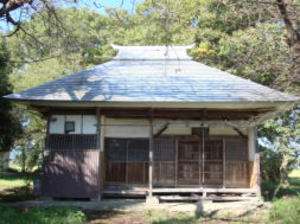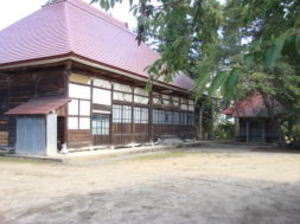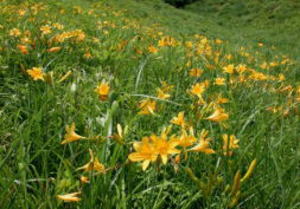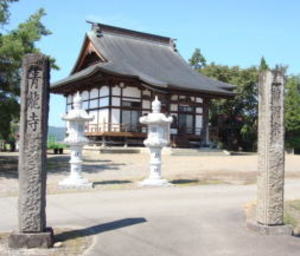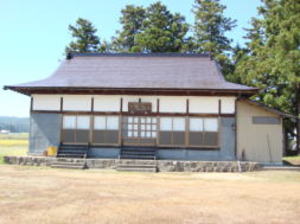the agricultural field maintenance in the vicinity, it rurns out to be
a complex ruins from the late Jyōmon period, the Yayoi
period and to the Medieval. In the excavated articles, ruins of residence with a Chipped-stone-axe
or a Kitchen-furnace,
Earthenware and Haji-pottery of each period, Iron sword, Celadon of the
Chinese Ryūsen-kiln system, Green-blue glazed
incense burner, Seto and Mino ware pottery etc. were excavated, it seems to have been able to know that it was a base of
people’s lives for a long time. It can be see that a considerable powerful
person lived in the Ashina governance period in the
Medieval. At the time of the Aizu invasion of Date Masamune in Tenshō 17 year (1589 year), Hōzō-ji temple in Shimo-
Kanazawa was destroyed by the fire during war, but at the same time Kanazawa-mansion
(Ippai-mansion) was also believed
to had been burned down by the fire during war. In the Aizu-Koruiki, the
Kanazawa-village-fortress, East-West 60-Ken (109m),
North-South 41-Ken (75m), in the past, it is said that Fujiwara-no Ōkura-Shōyū Masanori who is a deputy of the priest built
and lived. It is said that it was the time of Kan-nin 3 year (1019 year).
In this year, Ryūdenzan Hōzō-ji temple was built in the
Shimo-Kanazawa village by Fujiwara-no Masanori. In the Kenkyū years (1190
year ~ 1198 year), Ninagawa Jirō Kagetsura’s
child Minbu-Ōi Kageyoshi lived. Ninagawa Kagetsura is, he is the Mr. Sawara’s family who starts from Mr. Sawara Jūrō
Yoshitsura. In other words, it is a genealogy that the distant relative
of Mr. Ashina. In Ōei years (1394 year ~ 1427 year), Ishida
Masaoki was lived. After that, Doi Zaemon-no-jyō Katsutō was lived here.
This person is called Kanazawa Zaemon. It is said
that it lived in Tenshō years (1573 year ~ 1591 year).
What Kanazawa village is, in the current Shimo-Kanazawa settlements, Kanazawa-village-fortress is also called Ippai-
mansion, it is written that the details are not transmitted in the Aizu-Kagami
why it is called Ippai-mansion. The original
Kami-Kanazawa settlements is, it is said that it was just south of the
Shimo-Kanazawa settlements, but it is said that it moved
to the present location after the big flood of Shiro-Hige-no-Ōmizu (big
flood of the white beard) of Tenbun 5 year (1536 year).
(Welcome map, Aizu Bange town South area map)
It is located at the southern end of Aizu-Bange town, near the Ban-Etsu
Highway Niitsuru
IC (ETC-only gateway). West of Takada-Kaidō road in Gonohei district of Kami-Kanazawa
settlements, located at the alluvial fan shaped end of the ancient Sakase-gawa
river, it is
located on the tongue-shaped plateau ground protruding to the north. Stand
on here can see
it the Aizu plain overlooks, it is easy to judge that it is a great place to set up the castle and
mansion. The entire ruins are private property and it has become the arable land. The
earthworks, the moat,etc. are has not kept any ruins by the agricultural
field maintenance
etc. In the Excavation by the town before the construction work of Ban-Etsu
Highgway and
It is the Zalu (bamboo colander) used on a basis in the monk house of Takadera,
it is thought that it is settlements which was
opened considerably for a long time, because it is said that it was named
because it had been delivered from this settlements.
The whole area was called Funakoshi, and until around the Meiji and Taishō
periods, there were river ferry-boat coming and
going between the Shimo-Mandokoro on the opposite bank across the Tsurunuma-gawa
river. The Tsurunuma-gawa river of
old times was, it went north between the Zalu-Yashiki and Shimo-Mandokoro, and it joined to the Nippashi-gawa river in the
north-west of Aozu. Until the early Taishō period, water transportation
was thriving, Salmon, Trout fishing industry, Carp and
Dace fishing industry were also actively carried out. When a dam was built
for power development in the Shōwa period, the run
up of salmon and trout is lost and the fishing industry declines, and water traffic is abolished too. The hustle and bustle of
fishermen and sailors was gone, it is now a village with a peaceful rural landscape that supporting the rice place Aizu-Bange.
(Welcome map, Aizu Bange
town Norht-West area map)
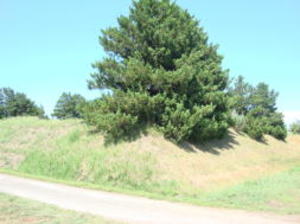
In the old days of Tachikawa village used to be a famous production place of Indigo. From the invitation of cultivation and
processing engineers from Awa country (Tokushima prefecture) in Meiwa
3 year (1766 year), next to the south of the main
temple hall, Kotohiragū shrine is transferred and enshrined. Indigo is
not produced now. The hall in the precincts is Shōten-dō
hall (back of photo) was built in Tenmei 2 year (1782 year), the bronze-made statue of the Secret Buddha Daishō-Kangi-Ten is
enshrined. It is the few Buddha statues in Aizu. In addition, the Dō-hall is enshrined in Aizen-Myō-Ō was transferred from
Ise
country (Mie prefecture) in Meiwa 3 year (1766 year). Tachikawa village
is, Tengi 5 year (1057 year) the Tōdera Hachimangū
shrine shinto priest list, it is a village that has been opened for old time
because the village name of Tachikawa is on it.
It is a famous
production area of Tachikawa Gonbo (Gobō, Burdock), a specialty product of
Aizu-Bange town.
(Welcome map, Aizu Bange town Norht-West area
map)
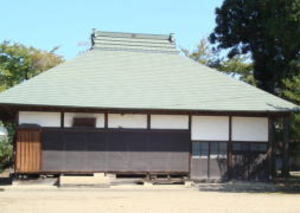
village of Onuma county are also designated as natural monuments of the
country. These are called the high-altitude type
Nikkōkisuge. The lowland type of Nikkōkisuge that swarms below 1,000m
at an elevation, it is thought that it spend many
years, and it was transformed to the cluster even in the lowland environment.
The clusters in the lowland, but the group is
also seen in the coastline of Hokkaidō and the northern part of Tōhoku, it is thought that climate is close to the highlands.
The lowland type Nikkōkisuge is, it has been designated and protected as an endangered species in various places. The flower
is flowering begins in the morning and wither in the evening, because
the bud opens one after another the colony becomes like
laying a yellow carpet. The flowering time in Aizu-Bange town is early
June. Since bears are infested these days, avoid act
independently on your own for appreciation, take thorough the bear measures, it is recommended to go out with more than one
person. It is around the 3rd ski lift boarding place.
(Welcome map, Aizu Bange
town Norht-West area map)
cultural property of Aizu-Bange town. In Ōei 20 year (1413 year) of the Aizu-Kujizakkō, it is said that Kakuyo was built the Muryō-
ji temple in the Niidate village of Inagawa-shō (manor) in the year. There
is 20 years period difference but, it might have been
rebuilt after it was caught in the infighting of the Ashina family and
I encountered the war disaster. Inside the Ashina family of
Ōei years (1394 ~ 1428 year), there was one after another it occurs of infighting with parents and children and vassals.
The infighting was frequent without completely fit. This was later, going
to take of the hegemony of Japan, it will be induced the
invasion of Aizu by Date Masamune of Yonezawa (Yonezawa city, Yamagata
prefecture).
Niidate village is, it is place where Tanaka-jyō castle was built in one
of the Aizu 8 mansions, that Jyō Shirō Nagamochi built at
the time of Hoan 1 year (1120 year). In the Aizu-Koruiki, Niidate-village-fortress,
East-West 82-Ken (194m), North-South 79-Ken
(144m) it is call Tanaka-jyō castle. There is to put the vassal Inomata Koroku, it is assumed that there was a mansion (around the
present Tōzen-ji temple) where Inomata Koroku lived. It is presumed that
the vicinity of this Muryō-ji temple was a place where
the military training place Matoba such as the bow and arrow of Tanaka-
jyō castle was in place. It is thought that the place name
of the Aza-place the entire village becomes "Tate-no-uchi", and the whole was Tanaka-jyō castle area. This temple is, together
with the Yakuōzan Tōzen-ji temple in this village, it seems to have served
as the management temple of Atago-shrine along the
old Echigo-Kaidō road. The sculptor of Buddhist statues Eshin is, if I’m
not mistaken wrong, it is an alias of the person who is
called Genshin in the priest of the Tendai-sect in the middle of the Heian
period. In the Jyōdo-shin-shū (sect), it is the 6th priest
of 7 high priests, and it is honorific title called "Genshin-Wajyō"
or "Gensin-Daishi", is also a person who is also honorific title
as
"Eshin-Sōzu-Genshin"
What that the 7 high priests of Jyōdo-shin-shū (sect) is, the 1st founder
Ryūju is Indian Buddhist monk "the Chinese translation
name of Nāgārujuna" Mahayana Buddhism Chyūkan-school and in Japan
it is called the founder of the 8 sect". The 2nd founder
Tenjin is ancient Indian Buddhist monk from Peshawar of Pakistan, the another name is Seshin, the translation name of
Vaspandu in Sanskrit. The 3rd founder Donran is the monk of the North-South Dynasty period in China, and the founder of the
Jyōdo-teachings of China. The 4th founder Dōshaku is Chinese Jyōdo-teachings monk of the
Tang Dynasty period. The 5th
founder Zendō is the Jyōdo-teachings of China. The 6th founder is Genshin. The 7th founder Genkū is another name Hōnen, a
monk from the end of Heian period to the early Kamakura period of Japan.
He is master of Shinran, believe in the vow of Amida-
Buddha and if recite the "Namu-Ami-Dabutsu", it say they can be equal after death "Sen-Ju-Nenbutsu"
it preachings.
The revered as the founder of the Japanese Jyōdo-sect. Say the people of
the 7 masters above.
(Welcome map, Aizu Bange
town Center area map)
The suburbs of the western part of Aizu-Bange town, it is located at the
southern end of the
Niidate village of the place, where the Kawanishi-Kaidō road entered the
north from National
route 49. This temple is said to be the place where there was one of the
Muryō-Bō (monk house)
the 36-Bō in Takadera, it is said the Ōei 2 year (1395 year) this temple was open temple by Rōyo.
Principal Buddha is Amida-Nyorai standing statue, which is said work to
be a sculptor of
Buddhist statues Eshin, the two attendants is followed by Kannon-Bosatsu
and Seishi-Kannon-
Bosatsu. It is reportedly to this temple, color painting on silk of Jyōdo-Mandara and color
painting on paper of Jyōdo high priest pictorial genealogy were, designated as an important
guardian of the village is enshrined in the east of the village. In the
Aizu-Koruiki, the Niidate-village-fortress, East-West 82-
Ken (194m), North-South 79-Ken (144m), it is called Tanaka-jyō castle.
It is thought that it is a place where Inomata Koroku of
the vassal is put, and it is a ruins of the mansion where Inomata Koroku
lived. It I thought that it was a considerably large
castle when thinking from the range of the district, and it is thought that there was a Matoba (training center of archery and
horsemanship. current the military exercise place) in the east of the
castle owner’s mansion perhaps. Along with the
"Jingamine-jyō castle" in the Unai district, it can be said
to be an important historical site of the Heian period in Aizu-Bange
town. Niidate is, it is place where there was a fork of the Shōbuzawa-road
of Echigo-Kaidō road and the Ketanomiya-road.
It is said that this temple served as the management temple by Atago shrine along the old Echigo-Kaidō road the Kimyōzan
The Niidate district is the birthplace of Aizu-Manzai (a comic dialogue), and the Saotome-Odori (rice-planting women dance)
has been handed down only to women in this district. Aizu-Manzai is, there
is lost, because no successor, but it is inherited by
Tayū (Manzai narrator) of Nishi-Aizu town, Yama county, it is performed
at weddings and Little-New-year’s events.
Saotome-Odori was also temporarily interrupted without a successor, in town the preservation society was inaugurated and
revived, in addition the Saotome-Odori-club established at Aizu Agricultural
and Forestry High School, and young successors
are growing up. Saotome-Odori is performed at the town’s Otaue (rice planting)-Festival.
(Welcome map, Aizu Bange
town Center area map)
The suburbs of the
western part of Aizu-Bange town, the place which entered
the north from
National route 49 of Kawanishi-Kaidō road, it is located at the northern end of Niidate
village. The foundation and open temple is unknown, but it is said that
it is around Keichō
years (1596 year ~ 1614 year) in the village. The principal Buddha is
Yakushi-Nyorai seated
statue.
The Aza-place-name of the whole village is Tate-no-uchi, it is the ruins of Tanaka-jō
castle, one of the Aizu 8 castles built in the Hoan 1 year (1120 year, end of Heian period) by
Jō Shirō Nagamochi. Excavations found a structural presumed to be a moat
site, but it is
said no evidence of the function of mansion and fortress was found. On the west side of this
temple, can see the wetlands that look like moat ruins.The current state of the castle area
surrounds the temple and is a residential area and arable land, and Hachiman
shrine of the

temple of the Senshō-ji temple in Iwaki city. In addition the Shinpen-Aizu-Fudoki, one of the Takadera 36-Bō Renge-Bō became
Renge-ji temple independently, since it became an abandoned temple afterwards,
it is said that the principal Buddha Amida-
Triad was moved to Kōgan-ji temple in Wakamatsu. In addition, the Renge-ji temple was built in Kayatsu village (now Kaizu
village) in Kawanuma county in Genkyū1 year (1204 year), but it is thought
that it is a revival of this temple. It is said that the
hanging scroll of Mandala, which is said to have been woven with Lotus
fiber, is handed down as a temple treasure and is owned
in the village's mayor's house.
In the Shinpen-Aizu-Fudoki, it is said that seven new rice fields were
reclaimed on the riverbed of the Tsurunuma-gawa river
in Genna 9 year(1623 year) of Mr. Gamō Tadasato reign, and encouraged those
who wished to settle the area. One of them was
Kamikayatsu village, which was later renamed Kami-Kaizu village. Because there was a wharf (port) of the waterborne traffic
which said "Tsu" in old Japanese words in the place where the
reed(Kaya) and saewrere the place where the river bed of the
Tsurunuma-gawa river was overgrown that "Kaya-no-tsu", and the
village name were called "Kayatsu".
The precincts are older than the Jyōfuku-ji temple, there is the Fudō-dō hall (photo left) which seems to be around Renge-ji
temple. There is a large tree of Ginkgo in front of the temple, In summer
the leaves grow thick and the grounds are covered
with a large shade, and put a lot of Ginkgo nut in autumn. In the time
of deciduous leaves, the whole precincts, it becomes like
laid the golden carpet. The day I visited for coverage was the time of the calm sunshine of autumn, there were drop down a lot
of ginkgo nut all over the precincts, and they smelled unique.In the Dagashi(candy) shop next to the precincts, when talked to
grandma who was a store keeper, "No one in the village picks it up.
Maybe there are afraid of Mr. Fudō." it was to say.
Certainly, Fudō-dō hall has a presence with the large ginkgo tree, I felt
like the Fudōson (Fudō-myō-ō, Acalanatha) was staring
at me.
(Welcome map, Aizu Bange town East area map)
Keichō 9 year (1604 year), a monk Shunmo was invites the 13th generation
Nyosatsu of Tennei-ji temple in Wakamatsu and it
revives as founder. At this time, it converted from Tendai-sect to Sōtō-sect. With the decrepit
of the main hall, rebuilt with a
meeting place in the Showa 40's (1965 ear ~ 1974 year, high growth period of Japan), in one corner, the Buddhist altars using
the previous parts is placed, and the principal Buddha is enshrined.
According to grandma’s story who was working in a nearby field, the Naka-Kaizu settlements used to be a very prosperous
village, but it was devastated by the disaster by the big flood of Shirohige
(big flood of the white beard) of Tenbun 5 year(1536
year). After that, the wasteland of the Tsurunuma-gawa river ruins was
reclaimed and the village was restored, in addition, it
is said that the rough fields was reclaimed in the year of the bad crops of Tenpō 6 year (1836 year). For reconstruction of the
village, it said because it became repeated of the many disasters and
bad crops such as wars, earthquakes, typhoons, floods etc.,
that from open village of Teiji 1st year(1362 year) the village spent
300 years to settle down but now, it is a village where a calm
rural landscape spreads that is can not feel the traces of a catastrophe.
(Welcome map, Aizu Bange
town East area map)
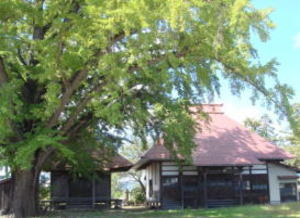
zakkō, Inagawa-Shō Kanazawa village's powerful clan Ishida Danjyō Masaoki
is, there is a description that the Jyōdo-sect monk
Enkū to the founder of the temple Ryūdenzan Hōzō-ji temple in village, and this year is the founding year in the origin and history
of the temple. Tenshō 17 year (1589 year), Date Masamune's invasion of
Aizu and destroyed by fire caused of war. Since then, it
have been under fire frequently in the Bunroku years (1592 year ~ 1595
year) and Meireki years (1655 year ~ 1658 year), and
have been repeats rebuilding each time. On the buddhist altars in main hall, "Enkyō 2 year (1745 year), Spring February lucky
day, Master-Carpenter Kuriki Sakuzaemon other 5 peoples" a written in sumi-ink is left. It is believed that it will be rebuilt in
Enkyō years after the fire of Meireki years, and it will reach the present
while adding restoration.
The opening village of this village is in Shinpen-Aizu-Fudoki and Aizu-Kujizakkō,
it is said that in Genna 7 year (1621 year) it
opens Shimo-Kanazawa village in Kawanuma county. There is a name of Kanazawa in the Tōdera Hachiman shrine shinto priest
list of Tengi 5 year (1058 year). In the Ashina period, it was an administratively
important place because a powerful Jitō of land is
assigned, after the Meiji period, it was the center of the eastern district
of Wakamiya.
In the Aizu-Koruiki, "Kanazawa-village-fortress, East-West 60-Ken
(109m), North-South 41-Ken (75m), old time an assistant to
the priest of Fujiwara-no-Ōkura Shōyū Masanori is built and lived"
and there, it is said that it was the time of Kan-nin 3 Year
(1019 year). During in Kenkyū years (1190 year ~ 1198 year), Minbu Ōi Kageyoshi
the child of Ninagawa Jirō Kagetsura was in
lived. Around Ōei years (1394 year ~ 1427 year), Ishida Masaoki was lived here.
Afterwards that, Doi Zaemonnojyō Katsutō lived.
This person is call Kanazawa Zaemon. It is said that he lived in Tenshō
years (1573 year ~ 1591 year). "Kanazawa village" is the
current Kami-Kanazawa village, and "Kanazawa-village-fortress"
is also called "One-cup-mansion(Ippai-date or yakata)". It is
said
that the details of why it is called One-cup-mansion in Aizu-Kagami are
not transmitted. In the excavation survey by the town
before the agricultural field improvement in the vicinity, from the ruins, earthenware in the late Yayoi period, medieval wooden
agricultural tools and dug-standing pillars ruins were excavated, and
it was seemed to be able to know that it was a base of
people's lives for quite a long time ago.
It is said that the original Kami-Kanazawa village was just south of Shimo-Kanazawa,but
it is said that it moved to the present place after the big flood of Shiro-higeno-Ōmizu
(big flood of white beard) of Tenbun 5 year
(1536 year).
(Welcome map, Aizu Bange town South area map)
It is located at the west end entrance of Shimo-Kanazawa settlements near
Wakamiya station
on the JR Tadami Line.
The founding of
this temple is older, it is said that there was one of
the 36-Bō of Takadera is Hōzō-Bō, and later became Hōzō-ji
temple. In the Aizu-Onko- Jyuyō
shō, in the Kan-nin 3 year (1019 year), it is said that Fujiwara-no-Masanori
built Ryūdenzan
Hōzō-ji temple in Kanazawa village, Kawanuma county. In addition, in the Aizu-Kujizakkō,
because there is also a Hōzō-ji temple memorial service, it might have
done the ceremony to
consecrate a newly temple. However, here is a considerably old temple.
The principal Buddha
is the seated statue of Amida-Nyorai.
In addition the Ōei 1 year (1394 year) of the Aizu- Kuji-
and in the Bunmei years (1469 year ~ 1486 year), Yamanouchi Matashichi
lived. At the time of Tenshōyears (1573 year ~ 1591
year), there was the place was a Hiwatashi-mansion where Hiwatashi Yajirō
lived, after the Yakushi-dō hall was built,
Mr. Yamanouchi lived in, and after that, it was ruled by Mr. Hiwatashi, and it is thought that Tōgen-ji temple was built on the
site of the Hiwatashi mansion in later years. The Aizu-Kujizakkō said
that in Bunmei 3 year (1471 year), red rash spread
throughout Aizu and many peoples died. Perhaps, because Rash typhus or
Scarlet fever or the Tsutsugamushi disease epidemic,
and a lot of lives were lost, it might have hoped for the disease dissipation
by constructing the Yakushi statue.
Rash typhus is an infection mediated by ticks and lice on clothing, and
it was also one of a cause for failure of Napoleon's
expedition to Russia in 1812 year. Anne Frank's cause of death in "Anne's Diary" is also believed to have been Rash typhus.
It is caused by badness to poor hygiene, in Japan it was epidemic from
the Pacific war to the post-war period, there are no
reports of onset after 1955 year. Still, let's keep the body clean including
clothes and bedding.
Scarlet fever is a
rash infectious disease common in children and is a type of immune allergic
disease.
It was designated as a
statutory infectious disease in Japan the Meiji period, but antibiotics have been developed to make treatment easier, by the
revision of the law in 1998 year, it is not statutory contagious disease.
Tsutsugamushi disease still develops mainly in agricultural work and civil engineering workers. It is onset of an illness by ticks
that prey on the eggs of insects in the soil. If it becomes severe, it
may lead to death from disseminated intravascular coagulation
syndrome or multi-organ failure. Since there is no preventive vaccine,
(1) It does not enter the contaminated area of the onset.
(2) Reduce skin exposure. (3) Do not inadvertently place your jacket or towel on the ground or on the grass. (4) Do not sit on the
grass or lie down. (5) Take a bath after coming home, clothing taken off
wash on quickly, etc. it is said to be a preventative
example.
In the farm field of the village, it is the legend of this village heard
from the grandma in the village in the farm work. Aizu-Bange
storyteller version of Yoshitsune's vassal who died in Hiwatashi.
Young people will know it Yoshitsune, right? It is said that
Minamoto-no-Yoshitsune was chased by Kamakura (Kamakura city, Kanagawa
prefecture), and came here. When came to
Hiwatashi, there were staying for about a month because a vassal, called
Kamei Rokurō got sick. However, since Kamei Rokurō
has passed away, to buried him and left for Shinobu (Fukushima city, Fukushima prefecture). It is said that the grave of Kamei
Rokurō was there until the Meiji period, but it is said that the whereabouts
are now it unknown. The legend of Minamoto-no-
Yoshitsune in the early Kamakura period it was also in Aizu-Bange town is’nt it?. Come to think of it when I was in elementary
school, I remember seeing it Benkei's wooden carrying box at the cultural
property exhibition of the cultural festival of the town.
Benkei is Yoshitsune’s vassal.
(Welcome map, Aizu Bange
town South area map)
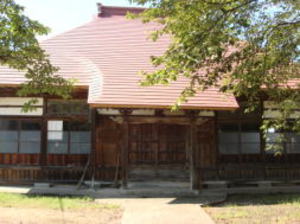
Hiwatashi-mansion, which is described as where Hiwatashi Yajirō was lived. It is thought that Mr. Yamanouchi lived in the
beginning, and it became the rule of Mr. Hiwatashi afterwards, and Tōgen-ji
temple was built in the ruins of the Hiwatashi-
mansion in later years. Mr. Yamano-uchi and Mr. Hiwatashi are vassals
and warlords of Mr. Ashina genealogy. It is said that
the whole village was burnt down because all the villagers of Hiwatashi did not follow Masamune's order at the time of Aizu
invasion of Date Masamune in Tenshō 17 year (1589 year). Looking in the
direction of Mt. Bandai from the temple area, it can
see the Aizu plain under the eyes, and in the location conditions of good
as a military bases, and the entire topography is
reminiscent of the ruins of the mansion. In the Shinpen-Aizu-Fudoki, it is said that the descendants will pray for the souls of
Hiwatashi Yajirō, who was the Jitō (lord of manor) of the land, and that
the descendants will build a temple in Tenshō 11 year
(1583 year), and the founder of a temple by begging the 10th generation
Shōzan Unkin of Tennei-ji temple (Aizu-Wakamatsu
city). The principal Buddha is a wooden standing statue of Jizō Bosatsu.
It is now a temple only for the main hall.
In the old days of
Sakase-gawa river was, head straight north from the Sakasegawa district of Niitsuru village Misato
town in
Ōnuma county was flowing the Hiwatashi settlements. The flow path was
greatly changed by the big flood of Shirohige (big flood
of the white beard) of Tenbun 5 year (1536 year), and it meandered greatly
to the east in the vicinity of the Yanata district in Niitsuru village,
currently the Akazawa-gawa river from Takada district of Misato town in
Ōnuma county, it joining to Miya-
gawa river at near the east side of Akutsu district in Niitsuru village.
At the time of the big flood of Shirohige of Tenbun 5 year, the destination
where the Niō-mon gate here leaked and drifted is
"Sugi Yakushi" in Aizu-Bange town.
(Welcome map, Aizu Bange
town South area map)
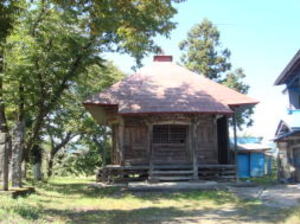
who escaped from the fire, such as the statue of Fudō-Myō-ō, the seated
statue of the Kokuzō-Bosatsu, the standing statue of Jizō-
Bosatsu, and the standing statue of Prince Shōtoku. Furthermore, when it is verified from the old stone Buddha on the left side of
the main hall, and the shrine of Kumano shrine enshrined in the right
back of the precincts, imagining that it was a magnificent
temple which was lined up with various temples such as Myō-ō-dōhall, Jizō-dō
hall, and Taishi-dō hall, centering on the main hall
at that time.
In the Aizu-Koruiki, "Ōe-village-fortress, East-West 48-Ken (87m),
North-South 46-Ken (84m), at the time of the
Enryaku years (782 year ~ 806 year), Asuka Shōyū Fujiuji Sanemoto of the chief priest of Shintō shrine lived. It says the Shō
(manor) and the hometown of Ōe from this. It is said the later, there
was a person who called Ōe, and there was Ōe Hyōbu in the
time of the Tenbun years (1532 year ~ 1555 year). It think that Seiryū-ji
temple was built in the ruin of Ōe-mansion.
There is not
trace of the mansion in the temple area. Several traces of the pillar were found in the excavation investigation before the
agricultural field improvement in the northwestern part of the settlement.
But, according to the villagers, it is said the relationship
with Ōe-mansion was not certain. In the "Wamyōrui-jyushō" of
Kenkyū 5 year (937 year), there is a name in Ōe-gō (hometown) as
the Aizu 9-gō. Ōe-gō is assumed to be the region of the present Wakamiya, Bange, Kawanishi, and the eastern part of Yahata.
A nationwide the land servey inspection (fields survey and yield survey, current tax ledger create)
by Toyotomi Hideyoshi, which
began in Tenshō 9 year (1581 year), at the same time as the Shōen (manor)
system was abolished, Ōe-gō was also abolished, but t
he name of Ōe, which was Mr. Ōe's control ground, remained here.
"Wamyōri-jushō" is a dictionary made during the Shōhei years
(931 year ~ 938 year) in the middle of the Heian period. It was
compiled by Minamoto-no-Shitagō(Scholars and Waka poet of the Heian period) at the request of Kinshi (the name of the modern
style is Isoko, 5th Royal princess of 60th Emperor Daigo) the Royal princess. It is created with reference to the "Jiga" in China's
oldest dictionary of synonyms, the dictionary of interpretation of words.
The contents are diverse and contain elements such as
modern Japanese dictionary, Chinese-Japanese dictionary, encyclopedia, place name and personal name dictionary. It is an
important historical material to know the society, manners and customs,
and administrative system of the Heian period, and it is
said that it is especially valuable in the research of the history of
Japan. The original book does not exist, it is told only by the
printed copies book from the beginning.
The complete printed copies book are owned by the Tokyo university language
laboratory,
the National museum of history and folklore, and the National archives.
(Welcome map, Aizu Bange
town South area map)
Push the page bottan
South of Aizu-Bange town, from the front of Wakamiya elementary school in Wakamiya district
to the east about 0.6km, it is located on the entrance of the Ōe settlements.
At the Kenchō 9 year
(1604 year) in the Shinpen-Aizu-Fudoki, it is said that Seiryū-ji temple
was founded in Ōe village
of Kawanuma-county, by the Sōtō-sect’s monk Shōkaku. Principal Buddha is standing statue of
Shaka-Nyorai.
Although it declined temporarily, the restoration by Son-eki in Kanbun
years
(1661 year ~ 1672 year), after that, it became the branch temple of Daitoku-ji
temple from the
invitation as the founder to the 4th generation Dōgai of Ushizawa Daitoku-ji
temple to the present.
The temple main hall etc. were burned in the Shōwa 59 year (1984 year). The following year,
reconstruction to the present condition. In Shumidan of main hall, various
Buddhas are enshrined
Kanazawa-mansion
(Ippai-mansion) ruins
Shingon-sect Buzan-school Yōrakuzan En-yō-ji temple
Shingon-sect Chizan-school Tōkokuzan Ryūsen-ji temple
Clusters of Nikkōkisuge Mt. Mimyō is
secret flower garden!
temple in Aizu-Bange town, I think that it is a Shingon-sect or the Jyōdo-sect
from the point where the cemetery is a Jyōtoku-ji
temple of the village north and the Naka-Mandokoro. In addition, Kōshō-ji temple was opened in Kan-ei 1 year (1624 year), so
it guess that the foundation of the temple was around this time. The one
corner of the temple is now used as a meeting place in
the village. It seems to have been enshrined in the disaster dissipation
and child-rearing in wishes are realized, the little
statuettes of Yakushi-Nyorai seated statue and Jizō-Bosatsu standing statue
are enshrined together. On the grounds, the
"Hyakumanben (praying a million times)" tower was built in March of
Hōreki 11 year (1763 year), and don't know the date of
creation, but the old Buddha statue it made from stone is enshrined.
(Welcome map, Aizu Bange town Center area map)
North of Aza-Shijukkoku in town, a small settlement across the "Saiwai-bashi
bridge" over
the Tsurunuma-gawa river is Izumigawara settlements.
In the Shipen-Aizu-Fudoki, it is
said that seven new rice fields were reclaimed on the riverbed of the Tsurunuma-gawa river
in Genna 9 year (1623 year) of Mr. Gamō Tadasato reign, and encouraged those who wished to settle the area. One of them was name of Izumi village, which was later renamed Izumi-
gawara village. The temple at the northern end of the village is Kannon-dō
hall, and the
standing statue of Shō-Kannon-Bosatsu is enshrined.
The sect is not known in detail. But
the family temple is Shōjyō-ji temple in Yugawa village, Kawanuma county,
and Kōshō-ji
Izumigawara Kannon-dō
hall
The southeast end of Aizu-Bange town, it came off from "Welcome map, Aizu-Bange town
East erea map" but further south of Naka-Kaizu settlements, it is
located in the west of
Kami-Kaizu settlements near the Ban-Etsu highway.
The founding of this temple is
unknown but in the Ihon-Tōdera-Nagachō (defferent-book Tōdera Long-book) "Renge-ji temple was built in Genkyū 1 year (1204 year). Principal Buddha is Amida-Nyorai-Triad.
Later it enshrined in the reception hall of Kōgan-ji temple in Kurokawa
(old name of Aizu-
Wakamatsu city)", it is thought isn’t that about this temple of the initially. Eventually it
becomes dilapidated temple and it is said that the Jyōfuku-ji temple was
built in the present
place in later years. It is said that there are not a lot of people who know that it is the branch
Jōdo-sect Sanshinzan
Jōfuku-ji temple
It is located in the Naka-Kaizu settlements in the Kaizu village of Miya-gawa
river east, in
the eastern part of Aizu-Bange town. Unknown years of the founded and
open temple.
Principal Buddha is Shaka-Nyorai seated statue.
In Aizu-Kagami, Teiji 1st year(1362 year)
of the northern dynastie in the northern and southern dynasties period,
lord of the manor
Satō Saemonnojyō Motokiyo was, two houses and rice field 3-Chōbu (29,700m²)
it reported
that it to donates it to the Jissō-ji temple of Kurokawa (old name of Aizu-Wakamatsu city).
In the Shinpen-Aizu-Fudoki, afterwards the place which became an abandoned
temple,
Sōtō-sect Kohōzan
Enmei-ji temple
Sōtō-sect Shōgenzan
Shinpuku-ji temple
Jōdo-sect Ryūdenzan Hōzō-ji temple
About 1km south down the T-shaped road in front of the Ōe settlements in Wakamiya village,
it is located place on the western end of the Hiwatashi settlements, through
out the tunnel
on the Ban-Etsu highway. It is commonly called Hiwatashi Yakushi-dō hall.
Unknown the
denomination. The main buddha is standing statue of Yakushi-Nyorai.
In the Aizu-Kagami,
it is said "In the document of Yakushi-dō hall, on Bunmei 3 year (1471 year) October 28, the
wishing lord is Enkōbō, Tōgakubō, Yamanouchi Matashichi, Shugendō Nanryūin
head temple
Nangakuin. It is said that it was founded in the year.
Hiwatashi-mansion is on Aizu-Koruiki, East-West 38-Ken (69m), North-South 31-Ken (56m),
Nanryūin
Yakushi-dō hall
Sōtō-sect Ōezan
Seiryū-ji temple
The northeastern part of Aizu-Bange town, turn to right at the Satō-bun
intersection of
Kitakata-Kaidō road, about 2km through the forest of Hirose shrine, it
is located at the
eastern end of Tachikawa village along the Ō-kawa river (Aga-kawa river).
The founded and
open temple is unknown years. The principal Buddha is seated statue of Dainichi-Nyorai.
In ancient times, it is said that it was about 300m north futher than the
present place.
It was frequently hit by floods, in the lowland which is a rice field now.
It is said that the
driftwood which drifted at the time of the flood was stored, and the temple was relocated to
the present location with the diversion material. Although there has been
a restoration since
then, it is said that it does not encounter a fire and it reaches the
present.
Once in a while, let’s look at nature. Aizu-Bange town is a town with a
rich environment of
nature. Here are introduce some of them. It is cluster place of Nikkōkisuge
of the town
managed ski resort (elevation 270m) adjacent to "hot spring facilities Shiori-no-Yu Bange" in
the Mimyō district.
Nikkōkisuge is a plant that originally cluster in a plateau of elevation
1,000m or more. In Aizu, the colony of Oguni-numa (swamp, elevation 1,000m) in Kita-
Shiobara village of Yama county, has been designated as a national natural
monument.
There are also clusters in Oze-ga-hara (elevation 1200m, Oze National
park), but it concerned
that in recent years the damage caused by wild deer is spreading. The colony of Komado
wetland swarms (elevation 1,000m) in Minami-Aizu town of Minami-Aizu county
and Showa
Sōtō-sect
Reishōzan Tōgen-ji temple
North 0.5km on Niidate village. Passing through in front of approach of
Yasaka shrine, it is
located in the middle of the Zaru-yashiki settlements built on the riverside terrace of the
Tsurnuma-gawa river.
Unknown details of the founded and the open temple. Principal
Buddha is seated statue of Dainichi-Nyorai, and following two attendants
of Fudō-Myō-Ō and
Jizō-Bosatsu. In the legend, it is said that it is the ruins of the Manzō-Bō the one of the 36-Bō
of Takadera. Since the place name of the temple’s place is Furuyashiki,
it is thought too that
it is that ruins of the mansion where Mr. Ashina’s vassals lived. It is
said that the monk
Senshiki was a chief priest, in the Tenshō years (1573 year ~ 1592 year). The origin of the
settlements name of the Zaru-yashiki it was the time of the prosperity of Takadera.
Jōdo-sect Kimyōzan Muryō-ji tempe
Shingon-sect
Buzan-school Yakuōzan Tōzen-ji temple







